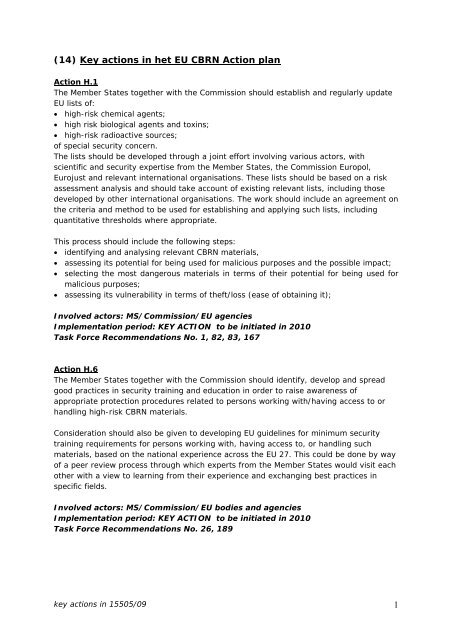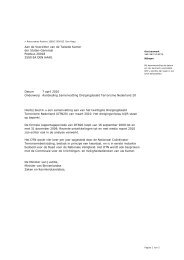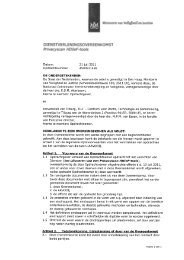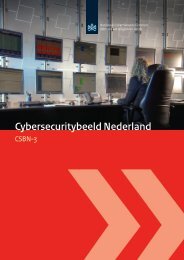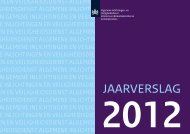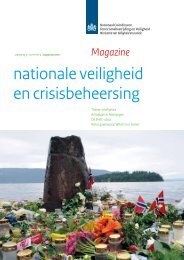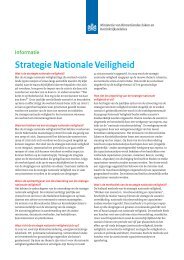Key actions - National Coordinator for Security and Counterterrorism
Key actions - National Coordinator for Security and Counterterrorism
Key actions - National Coordinator for Security and Counterterrorism
Create successful ePaper yourself
Turn your PDF publications into a flip-book with our unique Google optimized e-Paper software.
(14) <strong>Key</strong> <strong>actions</strong> in het EU CBRN Action plan<br />
Action H.1<br />
The Member States together with the Commission should establish <strong>and</strong> regularly update<br />
EU lists of:<br />
• high-risk chemical agents;<br />
• high risk biological agents <strong>and</strong> toxins;<br />
• high-risk radioactive sources;<br />
of special security concern.<br />
The lists should be developed through a joint ef<strong>for</strong>t involving various actors, with<br />
scientific <strong>and</strong> security expertise from the Member States, the Commission Europol,<br />
Eurojust <strong>and</strong> relevant international organisations. These lists should be based on a risk<br />
assessment analysis <strong>and</strong> should take account of existing relevant lists, including those<br />
developed by other international organisations. The work should include an agreement on<br />
the criteria <strong>and</strong> method to be used <strong>for</strong> establishing <strong>and</strong> applying such lists, including<br />
quantitative thresholds where appropriate.<br />
This process should include the following steps:<br />
• identifying <strong>and</strong> analysing relevant CBRN materials,<br />
• assessing its potential <strong>for</strong> being used <strong>for</strong> malicious purposes <strong>and</strong> the possible impact;<br />
• selecting the most dangerous materials in terms of their potential <strong>for</strong> being used <strong>for</strong><br />
malicious purposes;<br />
• assessing its vulnerability in terms of theft/loss (ease of obtaining it);<br />
Involved actors: MS/Commission/EU agencies<br />
Implementation period: KEY ACTION to be initiated in 2010<br />
Task Force Recommendations No. 1, 82, 83, 167<br />
Action H.6<br />
The Member States together with the Commission should identify, develop <strong>and</strong> spread<br />
good practices in security training <strong>and</strong> education in order to raise awareness of<br />
appropriate protection procedures related to persons working with/having access to or<br />
h<strong>and</strong>ling high-risk CBRN materials.<br />
Consideration should also be given to developing EU guidelines <strong>for</strong> minimum security<br />
training requirements <strong>for</strong> persons working with, having access to, or h<strong>and</strong>ling such<br />
materials, based on the national experience across the EU 27. This could be done by way<br />
of a peer review process through which experts from the Member States would visit each<br />
other with a view to learning from their experience <strong>and</strong> exchanging best practices in<br />
specific fields.<br />
Involved actors: MS/Commission/EU bodies <strong>and</strong> agencies<br />
Implementation period: KEY ACTION to be initiated in 2010<br />
Task Force Recommendations No. 26, 189<br />
key <strong>actions</strong> in 15505/09 1
Action RN.13<br />
The Commission should analyse whether existing systems, in particular the IAEA's ITDB 1 ,<br />
provide sufficient in<strong>for</strong>mation <strong>for</strong> the users of the system. Europol should be closely<br />
involved in this analysis. If the analysis leads to the identification of gaps, further<br />
feasibility work should be conducted on the ways of addressing these gaps. This work<br />
should include considering the possibilities of the European CBRN database to address<br />
these gaps.<br />
Involved actors: Commission/EU bodies <strong>and</strong> agencies<br />
Implementation period: KEY ACTION to be initiated in 2010<br />
Task Force Recommendation No. 204<br />
Action H.20<br />
The Member States together with the Commission should:<br />
- develop scenarios at EU level based on EU wide risk assessment (including events with<br />
cross-border effects) built on existing scenarios <strong>and</strong> national experience while using the<br />
"black box" 2 mechanism;<br />
- carry out a gap analysis by creating a matrix <strong>for</strong> each developed scenario of what is<br />
needed to identify CBRN materials <strong>and</strong> the detection technology already available.<br />
Involved actors: MS/Commission<br />
Implementation period: KEY ACTION to be initiated in 2010<br />
Task Force Recommendations No. 45, 47, 127, 217, 220<br />
Action H.25<br />
The Member States together with the Commission should assess the feasibility of EU<br />
h<strong>and</strong>books on sampling <strong>and</strong> detection of CBRN materials <strong>for</strong> practitioners (e.g. operators<br />
of detection devices) in view of the creation of joint investigation teams as well as an<br />
action card <strong>for</strong> first responders, building on existing work done at the EU <strong>and</strong><br />
international level, <strong>and</strong> within the Member States. These h<strong>and</strong>books should be translated<br />
into all official EU languages.<br />
Involved actors: MS/Commission/ relevant stakeholders<br />
Implementation period: KEY ACTION to be initiated in 2010<br />
Task Force Recommendations No. 54, 149, 229<br />
1<br />
2<br />
Illicit Trafficking Database.<br />
The original "black box" was the World War II bomb sight whose internal mechanism was kept a secret.<br />
Later, it came to refer to any mechanism to which a variety of inputs could be given <strong>and</strong> whose outputs<br />
could be observed, but whose contents, that is, whatever it was that trans<strong>for</strong>med inputs into outputs,<br />
were unknown. In practice, this means that the input from the participating Member States' experts is<br />
expected to be extrapolated from existing locations, names, real events or situations to more general<br />
(still) real <strong>and</strong> relevant in<strong>for</strong>mation/scenarios. There<strong>for</strong>e, the aim of the debate will not be to analyse in<br />
detail the specific challenges individual Member Sates face, but rather to build on the knowledge of<br />
participating experts.<br />
key <strong>actions</strong> in 15505/09 2
Action H.29<br />
Each Member State should:<br />
• ensure that CBRN risks are appropriately taken into account in their emergency<br />
response plans (where applicable into both national <strong>and</strong> local plans) on the basis of<br />
risk <strong>and</strong> threat assessments. The requirements of possible criminal investigations <strong>and</strong><br />
<strong>for</strong>ensics should be adequately taken into account in these plans;<br />
• assess CBRN emergency response plans <strong>for</strong> high risk public locations <strong>and</strong> high-risk<br />
public events;<br />
• exchange in<strong>for</strong>mation with other Member States on their existing CBRN emergency<br />
response plans.<br />
Involved actors: MS<br />
Implementation period: KEY ACTION to be initiated in 2010<br />
Task Force Recommendations No. 59, 155, 235, 239<br />
Action H.31<br />
The Member States, together with the Commission, should develop <strong>and</strong> conduct, on the<br />
basis of risk assessments, regular exercises at European <strong>and</strong> international level.<br />
The Member States should develop <strong>and</strong> conduct, on the basis of risk assessments,<br />
regular exercises at local, regional, <strong>and</strong> national level.<br />
These exercises should involve <strong>and</strong> test cooperation of all relevant organisations,<br />
particularly of health, first responders, security radiation protection <strong>and</strong> judicial<br />
authorities; where appropriate, involvement of private sector stakeholders in such<br />
exercises should be <strong>for</strong>eseen. Possible criminal investigations <strong>and</strong> <strong>for</strong>ensics should be<br />
part of these regular exercises. These simulation exercises could also be focused on<br />
transnational cooperation of one specific type of organisation (law en<strong>for</strong>cement<br />
authorities, health services, or other responders. The Commission should ensure<br />
coordination of relevant exercises at EU level. Within the Framework of the Community<br />
Civil Protection Mechanism, simulation exercises should regularly address CBRN<br />
Scenarios.<br />
Involved actors: MS/Commission/EU bodies <strong>and</strong> agencies<br />
Implementation period: KEY ACTION to be initiated in 2010<br />
Task Force Recommendations No. 60, 154, 236<br />
Action H.34<br />
Further analysis is required to ensure that sufficient capabilities are available through the<br />
Community Civil Protection Mechanism in case of need. The Commission should<br />
there<strong>for</strong>e:<br />
• update the 2005 assessment of the capabilities that may be available in the event of<br />
CBRN incidents. A flexible approach should be developed, avoiding extensive data<br />
gathering <strong>and</strong> focusing on those types of assistance <strong>for</strong> which insufficient in<strong>for</strong>mation<br />
was available in 2005. The assessment should where appropriate take into account the<br />
location of the available capabilities to assess the response capacity made available by<br />
the Member States through the Community Civil Protection Mechanism;<br />
key <strong>actions</strong> in 15505/09 3
• on the basis of risk <strong>and</strong> threat assessment, explore the possible need <strong>for</strong> further<br />
developing CBRN modules in the framework of the Community Civil Protection<br />
Mechanism;<br />
• explore the feasibility of pre-positioning certain key modules in the event of large<br />
public events as a further way of enhancing European resilience against CBRN<br />
emergencies;<br />
• facilitate the implementation of Article 5 (6) of the Recast of the Civil Protection<br />
Mechanism.<br />
Involved actors: Commission/MS<br />
Implementation period: KEY ACTION to be initiated in 2010<br />
Action H.38<br />
The Member States together with the Commission should setup a network of specialised<br />
CBRN law en<strong>for</strong>cement units to facilitate the exchange of in<strong>for</strong>mation <strong>and</strong> good practices,<br />
organising joint training exercises <strong>and</strong> up-dating them on the latest developments.<br />
Involved actors: Commission/MS/Europol<br />
Implementation period: KEY ACTION to be initiated in 2010<br />
Action H. 40<br />
The Commission, together with the Member States, should facilitate the preparation of an<br />
EU Emergency Response Guidebook <strong>for</strong> first responders, based on existing national<br />
practices, applicable to the context of CBRN emergencies. The guidebook would be<br />
provided to the Member States free of charge <strong>and</strong> could be translated into all official EU<br />
languages. As part of the process of preparing an Emergency Response Guidebook, a<br />
stocktaking of existing documents/guidebooks should be conducted.<br />
Involved actors: Commission/MS<br />
Implementation period: KEY ACTION to be initiated in 2010<br />
Task Force Recommendations No. 72, 252<br />
Action RN.23<br />
The Commission should further investigate the possibility of using the RODOS 3 <strong>and</strong><br />
ARGOS 4 or other similar Decision Support Systems to address CBRN releases (e.g.<br />
radiological dispersal devices, events such as the polonium incident in 2006, etc.), as<br />
well as the development of transport <strong>and</strong> dispersion models <strong>for</strong> large buildings (e.g.:<br />
airports, railway stations) <strong>and</strong> underground systems.<br />
Involved actors: Commission<br />
Implementation period: KEY ACTION to be initiated in 2010<br />
Task Force Recommendation No. 251<br />
3<br />
4<br />
Real-time On-line Decision Support system <strong>for</strong> off-site emergency management in Europe.<br />
Accident Reporting <strong>and</strong> Guidance Operational System.<br />
key <strong>actions</strong> in 15505/09 4
Action H.54<br />
The Member States together with the Commission should establish a law en<strong>for</strong>cement<br />
Early Warning System (EWS) <strong>for</strong> incidents related to high risk CBRN materials, taking<br />
account of existing systems <strong>and</strong> experiences. Such a mechanism would include<br />
in<strong>for</strong>mation on immediate threats, losses/thefts, <strong>and</strong> suspicious trans<strong>actions</strong> <strong>and</strong> would in<br />
any case need to be accessible to the law en<strong>for</strong>cement authorities <strong>and</strong> relevant<br />
emergency responders of the Member States <strong>and</strong> to Europol. As a first step, the<br />
extension of the existing G6 system could be considered. The system should be without<br />
prejudice to the exchange of in<strong>for</strong>mation on public health issues.<br />
Involved actors: Commission/EU bodies <strong>and</strong> agencies<br />
Implementation period: KEY ACTION to be initiated in 2010<br />
Task Force Recommendations No. 11, 12, 203<br />
Action H.55<br />
The Member States, together with the Commission, should develop <strong>and</strong> conduct, on the<br />
basis of risk assessment, regular training at European <strong>and</strong> international level.<br />
The Member States should develop <strong>and</strong> conduct, on the basis of risk assessment, regular<br />
training at local, regional, <strong>and</strong> national level.<br />
This training should involve <strong>and</strong> test cooperation of all relevant national agencies,<br />
particularly of health, first responders, security <strong>and</strong> judicial authorities; where<br />
appropriate, involvement of private sector stakeholders in such training should be<br />
<strong>for</strong>eseen. Existing Training <strong>for</strong> CBRN responders should be further developed to enhance<br />
interoperability.<br />
Involved actors: MS/Commission/EU bodies <strong>and</strong> agencies<br />
Implementation period: KEY ACTION to be initiated in 2010<br />
Task Force Recommendations No. 60, 154, 236<br />
Action H.65<br />
The Commission, in close consultation with the Member States, should launch studies on:<br />
• the necessity <strong>and</strong> impacts of assessing scientific research <strong>and</strong> scientific publications<br />
against security aspects;<br />
• the potential psychological effect of CBRN emergencies on the population <strong>and</strong> the<br />
likely re<strong>actions</strong> of local populations in case of incidents, <strong>and</strong> possible action-oriented<br />
responses;<br />
• the economic <strong>and</strong> social consequences of a CBRN terrorism incident <strong>and</strong> identify<br />
practical <strong>and</strong> action-oriented responses;<br />
• rehabilitation of contaminated areas following malevolent dispersal of CBRN materials,<br />
which also addresses the question of acceptable levels of residual contamination;<br />
• decontamination procedures which do not damage <strong>for</strong>ensic evidence.<br />
Involved actors: Commission<br />
Implementation period: KEY ACTION to be initiated in 2010<br />
Task Force Recommendations No. 74, 81, 126, 208, 254, 255, 264<br />
key <strong>actions</strong> in 15505/09 5


